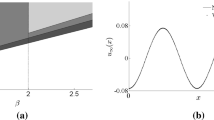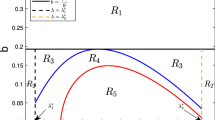Abstract
We consider a Turing-type reaction-diffusion system involving quadratic and cubic nonlinearities and numerically investigate the role of nonlinear terms in producing spots, stripes, labyrinths, hexagonal arrangement of spots, blotches and transitions among them. From our numerical experiments performed on a square domain with zero-flux boundary conditions, we observe that the system displays a form of multistability for which different stable spatial distribution of concentrations appear for a same set of control parameters depending upon the initial conditions. For varying values of model parameters both in the first- and the second-stage of simulations, we obtain a number of transition states that are found to be sensitive on the relative strength of the quadratic and cubic coupling terms. We obtain a graphical relationship among such model parameters at which the transitions take place.












Similar content being viewed by others
References
Turing, A.M.: On the chemical basis of morphogenesis. Philos. Trans. R Soc. Lond B 237, 37 (1952)
Murray, J.D.: A pre-pattern formation mechanism for animal coat markings. J. Theor. Biol. 88, 161 (1981)
Liu, R.T., Liaw, S.S., Maini, P.K.: Two-stage Turing model for generating pigment patterns on the leopard and the jaguar. Phys. Rev. E 74, 011914 (2006)
Bard, J.B.L.: A model for generating aspects of zebra and other mammalian coat patterns. J. Theor. Biol. 93, 363 (1981)
Murray, J.D.: Mathematical Biology, vol. I & II, 3rd edn. Springer, New York (2002)
Murray, J.D., Myerscough, M.R.: Pigmentation pattern formation on snakes. J. Theor. Biol. 149, 339 (1991)
Murray, J.D.: On pattern formation mechanism for lepidopteran wing patterns and mammalian coat markings. Philos. Trans. R. Soc. Lond. B 295, 473 (1981)
Nijhout, H.F.: A comprehensive model for color pattern formation in butterflies. Proc. R. Soc. Lond. B 239, 81 (1990)
Sekimura, T., Madzvamuse, A., Wathen, A.J., Maini, P.K.: A model for color pattern formation in the butterfly wing of Papilio dardanus. Proc. R. Soc. Lond. B 267, 851 (2000)
Kondo, S., Asai, R.: A reaction-diffusion wave on the marine angelfish Pomacanthus. Nature 376, 765 (1995)
Asai, R.: Zebrafish Leopard gene as a component of the putative reaction-diffusion system. Mech. Dev. 89, 87 (1999)
Shoji, H.: Origin of directionality in the fish stripe pattern. Dev. Dyn. 226, 627 (2003)
Barrio, R.A.: Modeling the skin pattern of fishes. Phys. Rev. E 79, 031908 (2009)
Liaw, S.S.: Turing model for the patterns of lady beetles. Phys. Rev. E 64, 041909 (2001)
Ben-Jacob, E., et al.: Generic modeling of cooperative growth patterns of bacterial colonies. Nature (Landon) 368, 46 (1994)
Tyson, R., Lubkin, S.R., Murray, J .D.: A minimal mechanism for bacterial pattern formation. Proc. R. Soc. Lond. Ser. B 266, 299 (1999)
Meinhardt, H.: Models of Biological Pattern Formation. Academic Press Inc., London (1982)
Liaw, S.S.: Phyllotaxis: its geometry and dynamics. Phys. Rev. E 57, 4589 (1998)
Röhrich, B., Parisi, J., Peinke, J., Rössler, O.E.: A simple morphogenetic reaction-diffusion model describing nonlinear transport phenomena in semiconductors. Z. Phys. B 65, 259 (1986)
Balkarei, Y.I., Grigoryants, A.V., Rzhanov, Y.A., Elinson, M.I.: Regenerative oscillations, spatial-temporal single pulses and static inhomogeneous structures in optically bistable semiconductors. Opt. Commun. 66, 161 (1988)
Nozakura, T., Ikeuchi, S.: Spiral patterns on a differentially rotating galactic disk-Self-organized structures in galaxies. Astrophys. J. 279, 40 (1984)
Mecke, K.R., Buchert, T., Wagner, H.: Robust morphological measures for large-scale structure in the universe. Astron. Astrophys. 288, 697 (1994)
Barrio, R.A., Varea, C., Araǵon, J.L., Maini, P.K.: A two-dimensional numerical study of spatial pattern formation in interacting turing systems. Bull. Math. Biol. 61, 483 (1999)
Leppnen, T., Karttunen, M., Barrio, R.A., Kaski, K.: Morphological transitions and bistability in Turing systems. Phys. Rev. E 70, 066202 (2004)
Barrio, R.A.: Size-dependent symmetry breaking in models for morphogenesis. Phys. D 168, 61 (2002)
Aragón, J.L., et al.: Turing patterns with pentagonal symmetry. Phys. Rev. E 65, 051913 (2002)
Schneider, J.T.: Perfect stripes from a general Turing model in different geometries, PhD Thesis, Boise State University (2012)
Aragón, J.L.: Spatial patterning in modified Turing systems: application to pigmentation patterns on marine fish. Forma 13, 213 (1998)
Werdelin, L., Olsson, L.: How the leopard got its spots: a phylogenetic view of the evolution of felid coat patterns. Biol. J. Linn. Soc. 62, 383 (1997)
Ouyang, Q., Swinney, H.L.: Transition from a uniform state to hexagonal and striped Turing patterns. Nature 352, 610 (1991)
Vanag, V.K., Epstein, I.R.: Translational and nontranslational motion of perturbed Turing patterns. Phys. Rev. E 67, 066219 (2003)
Rüdiger, S.: Dynamics of Turing patterns under spatiotemporal forcing. Phys. Rev. Lett. 90, 128301 (2003)
Vanag, V.K., Epstein, I.R.: Pattern formation mechanisms in reaction-diffusion systems. Int. J. Dev. Biol. 53, 673 (2009)
Yang, L., et al.: Turing patterns beyond hexagons and stripes. Chaos 16, 037114 (2006)
Yang, L., Epstein, I.R.: Symmetric, asymmetric, and antiphase Turing patterns in a model system with two identical coupled layers. Phys. Rev. E 69, 026211 (2004)
Dolnik, M., Berenstein, I., Zhabotinsky, A.M., Epstein, I.R.: Spatial periodic forcing of Turing structures. Phys. Rev. Lett. 87, 238301 (2001)
Karttunen, M., Provatas, N., Ala-Nissila, T., Grant, M.: Nucleation, growth, and scaling in slow combustion. J. Stat. Phys. 90, 1401 (1998)
Kim, T., Lin, M.: Stable advection-reaction-diffusion with arbitrary anisotropy. Comput. Anim. Virtual Worlds 18, 329 (2007)
Painter, K.J., Maini, P.K., Othmer, H.G.: Stripe formation in juvenile Pomacanthus explained by a generalized Turing mechanism with chemotaxis. Proc. Natl. Acad. Sci. USA 96, 5549 (1999)
Nakao, H., Mikhailov, A.S.: Turing patterns in network-organized activator–inhibitor systems. Nat. Phys. 6, 544 (2010)
Wu, F.: Multistability and dynamic transitions of intracellular Min protein patterns. Mol. Syst. Biol. 12, 873 (2016)
Cross, M.C., Hohenberg, P.C.: Pattern formation outside of equilibrium. Rev. Mod. Phys. 65, 851 (1993)
Maini, P.K., et al.: Turing’s model for biological pattern formation and the robustness problem. Interface Focus 2, 487 (2012)
Biancalani, T., Jafarpour, F., Goldenfeld, N.: Giant amplification of noise in fluctuation-induced pattern formation. Phys. Rev. Lett. 118, 018101 (2017)
Guiu-Souto, J., et al.: Characterizing topological transitions in a Turing-pattern-forming reaction-diffusion system. Phys. Rev. E 85, 056205 (2012)
Acknowledgements
This research did not receive any specific grant from funding agencies in the public, commercial, or not-for-profit sectors.
Author information
Authors and Affiliations
Corresponding author
Ethics declarations
Conflict of interest
All authors declare that they have no conflict of interest.
Ethical Approval
Since no human or animal participants are involved in this research work, no ethical standards were applicable.
Rights and permissions
About this article
Cite this article
Talukdar, D., Dutta, K. Transition of Spatial Patterns in an Interacting Turing System. J Stat Phys 174, 351–364 (2019). https://doi.org/10.1007/s10955-018-2182-y
Received:
Accepted:
Published:
Issue Date:
DOI: https://doi.org/10.1007/s10955-018-2182-y




